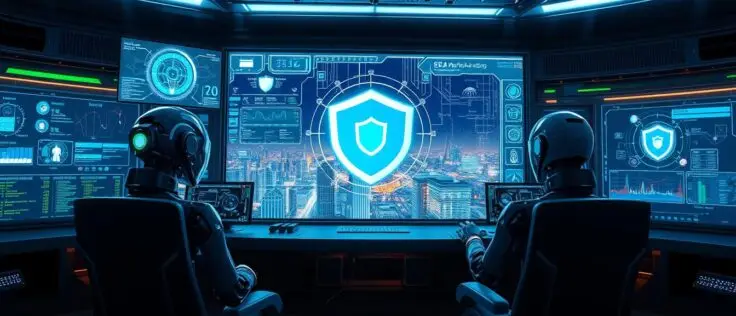In today’s connected world, cyber threats are on the rise. Using artificial intelligence (AI) in cybersecurity could be a game-changer. Can AI really foresee and stop threats, changing how we protect networks drastically? It’s essential to manage risks carefully in the digital sphere. Risk management is crucial as AI beefs up defense against complex attacks.
Many companies face data breaches. Introducing AI to cybersecurity gives us hope. AI in risk analysis can increase alert reviews by 55%, and cut fraud costs by up to 90%1. Tools like IBM QRadar® SIEM for threat detection and IBM MaaS360 for device management use AI. They provide amazing oversight and control1.
The large number of devices per company requires strong AI cybersecurity solutions. In this era, Google and IBM Watson use machine learning for better threat detection. Juniper Networks is developing a Self-Driving Network™. AI is becoming crucial2. Platforms like Balbix Security Cloud use AI for risk prediction and managing weaknesses2.
The Imperative for AI in Cybersecurity
In our world today, where everyone and everything is connected online, cyber threats keep growing. They require smarter, stronger responses. The global cost of a data breach has shot up to $4,450,000. This shows that old ways of protecting data are not enough anymore3. Now, using AI in our fight against cyber threats isn’t just a good idea, it’s absolutely necessary.
The Rise of Cyber Threats in a Connected World
The number of cyber-attacks is going up quickly. Experts predict a big rise in clever phishing attacks by 20243. These attacks are getting better at fooling people across different apps. Also, the recent big leaks of personal data show just how much we need strong cyber protection4. It’s crucial to keep our personal and business info safe.
The Role of AI in Proactive Threat Detection
AI is leading the way in finding threats before they attack. It uses its smart brain to look through tons of data quickly. It spots anything odd that might mean trouble is coming. This is key for catching dangers we know and those we don’t3.
Today, it’s vital to use tech that can think ahead and spot dangers early. AI can do this well. It helps organizations outsmart cybercriminals with continuous checks and smart threat finding.
Transitioning from Reactive to Predictive Security Posture
Moving to using AI for security means not just dealing with attacks but also stopping them before they start. AI tools can think and get better over time. They do this by learning from each threat they face3. This learning is key to keeping an organisation’s data safe, even from AI-based attacks.
It’s important to find the right mix of AI and human smarts in our defenses. This mix helps us not just respond to threats, but to stay one step ahead4.
Understanding AI-Powered Threat Detection
AI-powered threat detection is key in managing evolving cyber threats and dealing with lots of intelligence inputs5. It uses advanced algorithms, transforming how businesses predict and respond to threats6. With machine learning and deep learning, these systems process huge datasets. They identify anomalies and patterns that could be threats56.
From the 1970s, threat detection has moved from basic rule-based systems to sophisticated AI models5. These models analyze threats in real-time, reducing the chance for attacks and lessening potential harm quickly5. AI’s predictive abilities help fight current threats and foresee future ones, improving cybersecurity6.
Many sectors, including finance and healthcare, use AI in cybersecurity. It can analyse vast amounts of data quickly and precisely7. This ability ensures fast and accurate threat detection, leading to strong, effective security measures against emerging threats.
The development of AI Security Solutions is a major advance in improving strategic cybersecurity. These systems are crucial for real-time security. They help create a future where cybersecurity responses are quick, smart, and ahead of attackers.
AI in Cybersecurity: The Future of Intrusion Prevention
The fusion of artificial intelligence (AI) with cybersecurity marks a big change. It leads to stronger systems to stop cyber attacks. This tech makes it easier for companies to protect important data against complex threats instantly.
AI is changing how we protect networks. It helps spot new kinds of dangers that old methods might miss. With AI, security gets better and can keep up with the ever-changing danger of cyber threats8.
Enhanced Network Security Protocols
AI plays a key role in keeping networks safe. It can look through huge amounts of data quickly. This helps find signs of a possible security breach. AI systems learn on their own. This improves how they find threats without needing people, also reducing mistakes in spotting danger8.
Machine Learning in Anomaly Detection
Machine learning is also key in making cybersecurity stronger. It lets systems learn from past data. This helps them spot unusual patterns and dangers before they happen. They can then deal with threats very accurately8.
Having AI to defend systems right away is critical. It makes the response to threats faster. So, any unusual activities are dealt with instantly. This means less harm can be done8. It’s very important for keeping online services running smoothly and safely.
Real-time Defence Mechanisms
In summary, as cyber dangers grow, our defence plans must evolve. AI not only backs up crucial security tasks like stopping intrusions and spotting dangers. It also transforms how we defend systems in real-time. This makes security proactive, stopping threats before they even start.
Combating Data Breaches with Artificial Intelligence
Cyber threats are getting smarter, so our defences must too. AI in Cybersecurity leads the charge. It lets businesses spot and react to breaches fast and with precision. AI examines large datasets to find odd behaviors that usual methods might miss. This greatly reduces the chance of data breaches10.
AI-driven security automation outdoes old ways by handling routine tasks that take up much of the cybersecurity pro’s time. This change lets experts tackle tougher problems and big projects10. AI systems, like the one in IBM Guardium®, are key for better data watching, quick threat spotting, and meeting compliance needs smoothly10.
But, AI’s power comes with risks if it’s not managed well. A study by Grant Thornton UK LLP and Manchester Metropolitan University stresses the need to check AI-related cyber risks thoroughly at every AI lifecycle stage11. It’s about finding the right mix between machine work and human checks. This keeps biases away and ensures AI is developed ethically1011.
Using AI in cybersecurity doesn’t just make things easier. It’s vital in fighting the growing dangers of cyber threats. As AI becomes more central in cybersecurity systems, firms must be very responsible and forward-looking10.
The battle against cyber threats is ongoing, with hackers possibly using AI for clever attacks like fake emails or videos. AI’s role in cybersecurity is game-changing and essential10. When used right, AI not only better secures our digital space but also moves security forward, making it hard for intruders to get through10.
Security Analytics Powered by AI
Companies are facing new cybersecurity threats every day. Adding AI to their security helps them find and deal with dangers quicker and better. With AI, they can spot risks early and react swiftly and accurately.
Insights from Security Data Lakes
Security data lakes are crucial, storing lots of data. When used with AI and machine learning, they help spot security risks by finding unusual patterns. Experts believe AI will keep getting better at pulling useful info from these data lakes. This makes it faster to spot and deal with threats12.
Automating the Analysis of Security Feeds
AI is changing the game by automating security checks. It handles huge amounts of security data without needing much help from people. Thanks to this automation, analysts need half the time to look into threats. This speeds up finding threats and strengthens the defence of systems13.
Improving Decision-Making with AI Insights
AI doesn’t just look through data quicker; it also makes solving security problems easier. It gives security teams smart tips and automatic advice. This cuts down on the time it takes to fix issues and reduces harm. Using AI helps companies keep things running smoothly and stay safer against risks12.
Streamlining Malware Analysis with AI
Using AI in Cybersecurity has made Malware Analysis much better and more effective. AI uses predictive analytics and watches over behaviour to spot and stop malware threats more accurately14. It learns from past incidents with advanced machine learning, getting better at spotting threats. This cuts down on the time and effort needed for routine security jobs15.
AI in Cybersecurity is changing how organisations defend themselves. It can pick up on small warnings of danger, cutting down on human mistakes and boosting overall safety. This move to acting before threats strike means dangers can be handled before they do damage. AI systems are now catching malware between 80% to 92% of the time, which is way better than the old ways1516.
AI also helps Cybersecurity by making checking who people are more advanced through behaviour recognition. This means better security against cyber attacks1416. Companies using AI not only become safer but also work more efficiently. They can use their staff for jobs that need innovation and deep thinking.
The role of AI in spotting and stopping cyber threats is now essential as Cybersecurity grows. It ensures a safer online world and keeps companies ready to face complex cyber challenges quickly and with precision14.
AI-Driven Security Automation: The Way Forward
The rise of AI in cybersecurity marks a big leap in fighting cyber threats. Now, we can spot and react to dangers faster. This isn’t just changing the game in defence strategies; it also means less human mistakes. is crucial, especially when the economy is unstable. Using AI can help keep things stable17.
Autonomous Security Operations
At the core of changing cybersecurity are Autonomous Security Operations. They use AI and machine learning to quickly go through a lot of data. This helps find and deal with cyber threats fast17. Security Orchestration, Automation, and Response (SOAR) systems also play a big role. They react to threats quickly without needing humans to step in17.
Reducing Human Error through Automation
Bringing AI into cybersecurity cuts down on mistakes by automating decisions. AI for IT Operations (AIOps) changes how networks are managed. It automatically finds and stops security risks, making organisations safer17. As tech advances, using AI to stop phishing and data breaches is key. It’s essential for fighting clever cyber attacks17.
Looking ahead, AI in cybersecurity aims to make a secure online space. This means not just better security now but also lasting solutions. It’s about building on strong AI ethics and practices for the future.
AI in Cybersecurity: Enhancing Identification of Cyber Threats
Integrating AI into cybersecurity boosts our ability to spot and react to new cyber threats. AI, like IBM Watson, is great at looking through big data sets. It finds slight signs of danger that we might miss otherwise18. This skill is vital as organisations today deal with a lot of complex data.
Tools powered by AI, such as Darktrace, use machine learning to notice strange activity in networks. This helps catch threats early, ones traditional security might not see. Thus, AI is key for better threat intelligence and keeping organisations safe18. Respond Software shows that AI can quickly deal with common cyber dangers. This reduces the harm they can cause by speeding up how fast we respond18.
Using AI in cybersecurity definitely strengthens our defences. But, it’s important to remember AI needs strict data privacy controls18. The way AI handles sensitive data must be careful to avoid privacy breaches or data leaks. Also, the quality of data given to AI affects how well it works. Making sure the data is accurate and free from bias is key for sound security advice18.
As cyber threats get more complex, using AI to detect them helps improve our security. This move towards AI-driven security is crucial to handle advanced cyber dangers today19. In short, AI in cybersecurity not only spots dangers better but also provides an effective way to protect data and systems in our connected world.
The Integration of AI and Cyber Threat Intelligence
The world of cyber security is changing fast. It’s now combining with artificial intelligence, especially in threat intelligence. This mix makes security better and leads to advanced threat finding and smarter handling of cyber incidents.
Sophisticated Threat Hunting Techniques
Leveraging AI in Incident Response
Using AI changes how we respond to security threats. It moves from a wait-and-see approach to an active one. AI adds valuable info like who and where to help organisations get ahead of threats21. AI can handle complex cybersecurity tasks quickly and understand different languages, making it great at picking out important threat details from various sources2122.
In summary, AI and cyber threat intelligence are leading to safer, quicker, and smarter cyber security. As AI systems get better, they’ll help keep companies safe from new cyber threats.
Maximising the Potential of AI Security Solutions
AI Security Solutions are key in tackling modern cybersecurity complexities. They offer both proactive protection and innovative approaches. The power of AI lies in its ability to analyse vast data, helping to spot threats early, adjust security settings, and put preventive steps in place23. Moreover, AI helps craft security systems aiming for future safety. This ensures that systems are built with top-notch security from the start23.
Cybersecurity innovation soars with AI technology use. It brings better threat detection, quickly finding and addressing threats. This reduces the strain on security teams24. AI-driven Security Automation enhances threat response by automating tasks and offering immediate solutions, like isolating at-risk systems24.
AI takes a proactive defense stance by learning from past events to spot attack patterns24. As AI evolves, it constantly upgrades security approaches to battle new threats. This keeps organisations safe and flexible24. Transparency and oversight in AI are paramount, ensuring its correct use in delicate security tasks23.

Conclusion
The use of artificial intelligence (AI) in fighting cyber dangers marks a big leap towards stronger defence mechanisms. Today, the global market for AI in cybersecurity has grown to an impressive $17.4 billion in 2022. It’s expected to skyrocket to about $102.78 billion by 2032. This shows a yearly growth rate of 19.43% over the next ten years25. With more than 90% of cybersecurity experts worried about hackers using AI for advanced attacks, everyone agrees. We must improve AI security to protect organisations from these threats25.
Machine learning is crucial in the fight against harmful cyber activities. It significantly improves detection of unusual activity and strengthens defences against threats like SQL injections and cross-site scripting. Not to forget the ever-dangerous zero-day exploits. By implementing AI, we not only get better at spotting threats in real time but also set a strong foundation for adapting to cyber threats26. This era of AI Cybersecurity Evolution helps businesses change their strategies to face new online dangers. The fact is, in 2022, companies faced more cyberattacks each week than in the previous year25.
Combining AI with automated cybersecurity plays a key role. It reduces the time needed for manual tasks and makes human efforts more effective. As experts use machine learning for testing cybersecurity scenarios, they pave the way for game-changing security improvements26. This blend of AI and cyber threat intelligence is creating a future filled with smart and tough cybersecurity techniques. It represents a big change, positioning AI as a fundamental part of digital safety measures.
FAQ
How is AI transforming cybersecurity?
AI is changing the game in cybersecurity. It makes security operations quicker, more accurate, and efficient. By spotting threats fast and using predictive analytics, AI helps organisations be one step ahead. This proactive stance is key in today’s ever-changing threat environment.
What is the role of AI in combating the rise of cyber threats?
AI is crucial in fighting the growing sophistication of cyber threats. It boosts the ability to detect threats early. Using machine learning and spotting unusual behaviour, AI improves an organisation’s defence. This is essential in keeping ahead of cyber attackers.
How does AI contribute to the transition from reactive to predictive security?
AI moves security from a reactive to a predictive model. It does this by analysing data and spotting future vulnerabilities. With this foresight, organisations can act in advance, rather than just reacting after something happens. This proactive approach is more effective.
What is the importance of AI-powered threat detection?
AI-powered threat detection is vital. It spots attacks, both known and unknown, by looking at user and network behaviour. By intelligently analysing data, AI boosts the efficiency of cybersecurity. This makes it a key part of modern security systems.
How does AI improve intrusion prevention?
AI boosts network security by watching for unusual data access. This quick alert system helps stop intrusions early. Plus, its use of machine learning to detect anomalies allows for rapid, smart responses to threats. This greatly strengthens security measures.
How is AI utilised in combating data breaches?
AI fights data breaches with real-time monitoring and alerts. Tools like IBM Guardium® use AI for top-notch monitoring and spotting threats. This boosts an organisation’s defence against losing sensitive information. AI plays a critical role in data protection.
In what ways do security analytics benefit from AI?
AI takes security analytics to the next level. It analyses huge amounts of data, giving a clear picture of threats. This automation speeds up the decision-making for security professionals. With AI, insights are deeper and decisions are faster.
How has AI streamlined malware analysis?
AI has made malware analysis more effective. It uses predictive analytics and behaviour tracking for early detection. It also improves the accuracy of machine learning models. This makes security teams more efficient in dealing with threats. AI is a game-changer in fighting malware.
What are the benefits of AI-driven security automation?
AI-driven security automation reduces human error and boosts operational efficiency. It allows systems to act on threats automatically, working alongside human insight to improve threat response accuracy. This collaboration enhances overall security performance.
How does AI enhance the identification of cyber threats?
AI improves threat identification with advanced detection and intelligence. It can tell real users from attackers, allowing precise responses to various threats. This protects organisational assets more effectively. AI is key in identifying and responding to cyber threats.
How do AI and cyber threat intelligence integrate to improve cybersecurity?
AI enhances cyber threat intelligence by improving threat hunting and incident response. With AI, data analysis and pattern recognition help make informed decisions. This integration strengthens an organisation’s stance against cyber threats. AI and intelligence working together offer powerful cyber defence.
What potential does AI hold for the future of cybersecurity solutions?
AI has great potential in cybersecurity, moving beyond just detecting threats. It aims to predict and prevent attacks. With its ability to learn continuously, AI keeps security methods fresh and innovative. This ensures protection keeps up with the digital world’s changes.
Source Links
- Artificial Intelligence (AI) Cybersecurity | IBM – https://www.ibm.com/ai-cybersecurity
- Using Artificial Intelligence in Cybersecurity – https://www.balbix.com/insights/artificial-intelligence-in-cybersecurity/
- The Imperative of Cybersecurity in the Era of AI – https://www.thefastmode.com/expert-opinion/34470-the-imperative-of-cybersecurity-in-the-era-of-ai
- Cybersecurity in AI: A Critical Imperative? – https://www.linkedin.com/pulse/cybersecurity-ai-critical-imperative-ganesh-verma-diicf
- What Is the Role of AI in Threat Detection? – https://www.paloaltonetworks.com/cyberpedia/ai-in-threat-detection
- Role of Artificial Intelligence (AI) in Threat Detection – https://www.sangfor.com/blog/cybersecurity/role-of-artificial-intelligence-ai-in-threat-detection
- What is AI in Cybersecurity: Leveraging Artificial Intelligence for Threat Detection? – https://www.cybernx.com/a-what-is-ai-in-cybersecurity-leveraging-artificial-intelligence-for-threat-detection
- AI in Cybersecurity: The Future of Threat Detection and Preventions – https://www.linkedin.com/pulse/ai-cybersecurity-future-threat-detection-preventions-youssef-ahmed-7n2sf
- AI in Cybersecurity: Revolutionising Threat Detection and Prevention – https://www.acronyms.co.uk/blog/ai-in-cybersecurity/
- The Benefits And Challenges Of AI In Cyber Security – https://www.metacompliance.com/blog/data-breaches/benefits-and-challenges-of-ai-in-cyber-security
- Cyber security risks to artificial intelligence – https://www.gov.uk/government/publications/research-on-the-cyber-security-of-ai/cyber-security-risks-to-artificial-intelligence
- What are Predictions of Artificial Intelligence (AI) in Cybersecurity? – https://www.paloaltonetworks.com/cyberpedia/predictions-of-artificial-intelligence-ai-in-cybersecurity
- Security Operations Platform Powered by AI I Anomali – https://www.anomali.com/
- Embracing AI in Cyber Security – https://www.coretocloud.co.uk/embracing-ai-in-cyber-security-enhancing-cyber-calmness-and-empowering-human-experts/
- AI in Cyber Security: Top 6 Use Cases – TechMagic – https://www.techmagic.co/blog/ai-in-cybersecurity/
- The Relationship Between AI and Cybersecurity – https://safebase.io/resources/ai-and-cybersecurity
- What Is the Role of AI in Security Automation? – https://www.paloaltonetworks.com/cyberpedia/role-of-artificial-intelligence-ai-in-security-automation
- AI in Cybersecurity: Enhancing Threat Detection and Response – CyberHoot – https://cyberhoot.com/blog/ai-in-cybersecurity-enhancing-threat-detection-and-response/
- Impact of AI on Cyber Security – https://www.hornetsecurity.com/en/blog/impact-of-ai-on-cyber-security/
- AI Threat Intelligence: Empowering Cybersecurity Defence Strategies | Microminder Cybersecurity | Holistic Cybersecurity Services – https://www.micromindercs.com/blog/ai-threat-intelligence-empowering-cybersecurity
- AI Threat Intelligence: Automation in Cybersecurity – https://bigid.com/blog/ai-threat-intelligence/
- How Artificial Intelligence (AI) Can Help With Cybersecurity Threats | Fortinet – https://www.fortinet.com/resources/cyberglossary/artificial-intelligence-in-cybersecurity
- AI fighting AI: The future of cybersecurity – are you ready? – https://www.columbusglobal.com/en/blog/ai-fighting-ai-the-future-of-cybersecurity
- What Are the Risks and Benefits of Artificial Intelligence (AI) in Cybersecurity? – https://www.paloaltonetworks.co.uk/cyberpedia/ai-risks-and-benefits-in-cybersecurity
- AI in cybersecurity: A double-edged sword | Deloitte Middle East – https://www.deloitte.com/middle-east/en/our-thinking/mepov-magazine/securing-the-future/ai-in-cybersecurity.html
- How AI influences cybersecurity – https://kpmg.com/ch/en/insights/cybersecurity-risk/artificial-intelligence-influences.html






